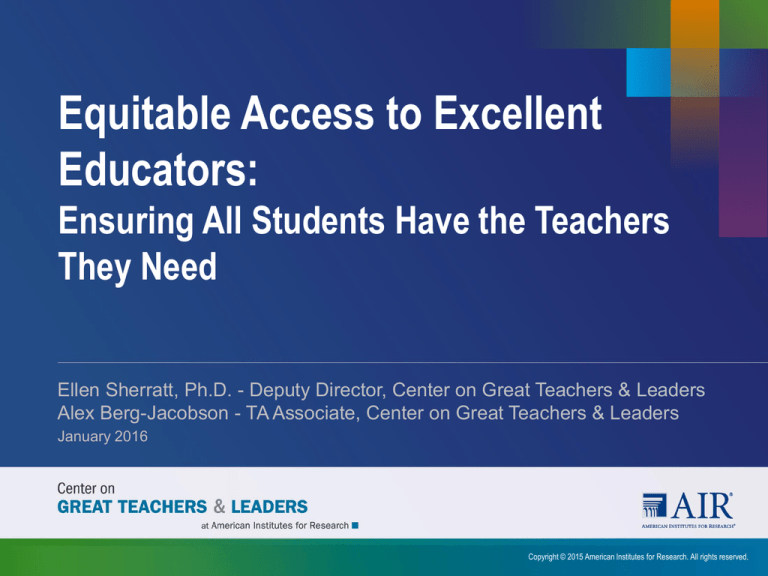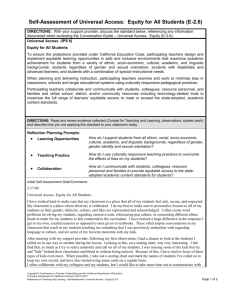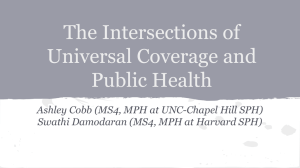
Equitable Access to Excellent
Educators:
Ensuring All Students Have the Teachers
They Need
Ellen Sherratt, Ph.D. - Deputy Director, Center on Great Teachers & Leaders
Alex Berg-Jacobson - TA Associate, Center on Great Teachers & Leaders
January 2016
Copyright © 2015 American Institutes for Research. All rights reserved.
Mission
The mission of the Center on Great Teachers and
Leaders (GTL Center) is to foster the capacity of
vibrant networks of practitioners, researchers,
innovators, and experts to build and sustain a
seamless system of support for great teachers
and leaders for every school in every state in the
nation.
2
Session Objective
Help education leaders at all levels of the system understand
how they can play their part in ensuring that low-income and
minority students are not shortchanged in their access to
effective educators by:
Providing an overview of the federal Excellent Educators for All initiative
Presenting the research base surrounding equitable access
Discussing themes, examples, and lessons learned from state equity
planning
Sharing practical takeaways and suggestions
3
What is the Federal Excellent Educators for All
Initiative?
How familiar are you with the Excellent Educators for All
initiative?
Not at all
Somewhat
Very
4
What is the Federal Excellent Educators for All
Initiative?
The Excellent Educators for All initiative required that all states
develop plans to ensure equitable access to excellent
educators for all students
State education agencies were required to submit “equity plans” to the U.S.
Department of Education by June 1, 2015
Plans included information on the “equity gaps” between poor and minority
students’ access to great teachers and the access had by their peers
Plans also included strategies for addressing equity gaps
5
2006 Equity Plans
The 2002 reauthorization of the Elementary and Secondary
Education Act, known as No Child Left Behind, called for all
students to be taught by highly qualified teachers by 2006.
States also were required to create plans to ensure that poor
and minority students are not taught at higher rates than other
students by underqualified, inexperienced, or out-of-field
teachers.
The 2006 and revised Highly Qualified Teacher plans are
available at:
http://www2.ed.gov/programs/teacherqual/hqtplans/index.html
6
2015 Equity Plans
Revisit the extent to which equity gaps persist with respect to
poor and minority students and unqualified, out-of-field, and
inexperienced teachers.
States can also look at other definitions of excellent teachers and other
measures (e.g., turnover).
Consider the root causes of existing gaps.
Design or describe strategies to address root causes.
Put forward plan to monitor and assess progress in reducing
any existing gaps.
Almost all plans are now approved ad available here:
http://www2.ed.gov/programs/titleiparta/resources.html
7
2015 Equity Plans
Required that stakeholders be engaged in the development of
the plan:
Teachers
Principals
Districts
Parents
Community organizations
8
Excellent Educators for All Initiative
Created the Equitable Access Support Network (EASN) to:
Provide intensive coaching to states
Create topical communities of practice for state leaders
Provide a vehicle for requesting assistance on developing equity plans
Connect leaders to resources and tools to conduct equitable access work:
https://easn.grads360.org/#program
Created data profiles for states to begin the data analysis
process
Involved significant support from federal technical assistance
groups
Involved multiple rounds of reviews of draft plans
9
What Does the Research Say?
The following student groups are less likely to have access to
great teachers and school leaders, according to almost every
metric available:
Students of color
Students from low-income families
Rural students
Students with disabilities
Students with limited English proficiency
Students in need of academic remediation
Source: Institute of Education Sciences; data from the U.S. Department of Education’s Office for Civil Rights
10
What Does the Research Say?
Source: Glazerman & Max, 2011, as shown in Institute of Education Sciences, 2014, p. 6.
11
What Does the Research Say?
Source: DeMonte & Hanna, 2014, p. 4.
12
Poverty in America
Twenty percent of American children live in
poverty.
More than half of public school students are
eligible for free or reduced-priced meals.
Most big cities with high concentrations of
low-income students have graduation rates
in the 60 percent range
Upward mobility in the United States is a
dream deferred for most poor children; if
you are born poor, you are likely to remain
poor your entire life.
Sources: Cookson, 2013, Child Trends, 2015
13
Barriers to Opportunity
Disproportionate numbers of students
with disabilities and African American
youth receive suspensions; and students
who are removed from school have a
much higher likelihood of involvement in
the juvenile delinquency system
Current trends suggest that one of every
three Black American males born [in
2013] will go to prison in his lifetime
Sources: Gonsoulin, Zablocki, & Leone, 2012, p. 309; The Sentencing
Project, 2013, p. 1
14
What Does the Research Say?
There is no silver bullet to addressing these challenges;
research suggests a large range of strategies are important for
attracting, retaining, and developing effective teachers and
principals
Therefore, local data collection & stakeholder engagement is key to determining
where to begin
15
16
What Have We Learned To-Date?
• Most states developed very strong plans with their
stakeholders
• States are not focusing on redistributing educators but rather
are focusing on recruiting, retaining, and developing educators.
• Multiple states went beyond the requirements to include
English language learners and students with disabilities in their
analysis
• States focused heavily on teacher professional development,
preparation, and school leadership
17
Common Strategies from Approved 2015 Plans
Improve Educator Preparation and Certification
30
Improve or Expand Professional Development
29
Improve Recruitment and Hiring Practices
18
Improve Teacher Mentorship
18
Improve State Equity Infrastructure
17
Improve Leadership Support and Professional Development
17
Improve or Differentiate Financial Incentives
16
Provide Targeted Support to High Need Schools
15
Reviewing and Possibly Reforming Hiring and Placement Practices
15
Improve Working Conditions
14
0
10
20
30
40
18
What Have We Learned To-Date?
Some innovative strategies included:
Crosswalking the equity plan with other strategic plans for improving
teacher and principal quality
Using talent development or human capital management systems
approaches to address all relevant policy areas and ensure the coherence
across policy areas
Developing teacher leadership opportunities and teacher career ladders
Collecting new data on root causes, such as school climate data and exit
surveys to better understand the reasons teachers leave high-poverty and
high-minority schools
Collecting more consistent teacher shortage data and/or educator shortage
predictor models to ensure sufficient supply to meet demand statewide and
in particular geographic and subject areas
19
What Have We Learned To-Date?
Key challenge areas for states included:
Completing a high-quality plan within a compressed
timeline
Defining and identifying data on excellent teaching and
leading
Identifying root causes in the absence of root-cause
data
Determining strategies that are realistic given state
budgets, and that fall within a state education agencies
purview
Building capacity for widespread, authentic
stakeholder engagement and communication
20
What Can YOU Do To Promote Equitable
Access?
How involved have you been in your state’s equitable access
planning process?
Not at all
Somewhat
Very
21
What Can YOU Do To Promote Equitable
Access?
Possible action steps for your district:
Review your state’s equity plan and identify ways to collaborate with state
leaders in implementing it locally and in revising it over time
Develop a local equity plan, whether or not your state requires it
Collect data on your equity gaps and on the root causes behind them
Conduct a policy gap analysis using a Talent Development Framework
Engage teacher leaders and all teachers and other stakeholders in
considering how best to ensure equitable access to excellent teachers
Consider using the Everyone at the Table approach: www.everyoneatthetable.org and Equitable
Access Choicework guide:
http://www.publicagenda.org/files/PublicAgenda_Choicework_HowCanWeEnsureThatAllChildre
nHaveExcellentTeachers_2015.pdf
22
What Can YOU Do To Promote Equitable
Access?
Possible action steps for your educator preparation program:
Review your state’s equity plan and identify ways to collaborate with state
leaders in implementing it in your program and in revising it over time
Coordinate with districts to admit and recruit candidates that will best help
them address teacher shortages and meet their equitable access needs
Develop or refine clinical experiences in high-need settings
Incorporate cultural competency into your courses
Action steps for state leaders:
Implement your plan!
Continually improve on your plan
23
GTL Center Implementation Supports
The GTL Center Implementation Playbook includes:
Implementation Planning Tool
Communication Guidebook
Creating Coherence and Alignment Tool
Monitoring Tool
LEA Implementation Tools
24
Implementation Planning Tool
The Implementation Planning Tool is a step-by-step tool designed to support
SEAs wherever they are in the implementation process.
States can use this resource to:
• Assess community awareness about their state equity plan
• Identify a project leader and team to implement their equity
plan strategies
• Assess current levels of implementation
• Clarify leading indicators of success
• Create a project management plan and act on the plan!
http://www.gtlcenter.org/sites/default/files/Implementation_Planning_Tool.pdf
25
Communication Guidebook
The Communication Guidebook is a step-by-step guide to developing and
implementing a communications plan to support equity plan implementation.
States can use this resource to:
Identify key audiences and messengers and effective
communication strategies
Develop key messages
Establish a project management plan for communications
Monitor the effectiveness of their internal and external
communications
http://www.gtlcenter.org/sites/default/files/Communication_Guidebook.pdf
26
Creating Coherence and Alignment Tool
The Creating Coherence and Alignment Tool is designed to support states to
improve coherence across policies and programs and alignment across
implementation of these initiatives.
States can use this resource to:
Assess coherence across state policies and programs
Improve the alignment of (1) funding streams, (2) staff
roles and responsibilities, (3) data management, and (4)
internal and external communications
http://www.gtlcenter.org/sites/default/files/Coherence_Alignment_Tool.pdf
27
Monitoring Tool
The Monitoring Tool is designed help states determine why some strategies
worked and others did not and develop action steps to improve outcomes.
States can use this resource to:
Create a strong plan to monitor implementation progress
Use this plan to identify evidence of progress toward
long-term goals
Take action to capitalize on successes and course-correct
as needed through a process of continuous improvement
http://www.gtlcenter.org/sites/default/files/Monitoring_Tool.pdf
28
LEA Implementation Tools
1. Research-supported implementation tips for LEAs
http://www.gtlcenter.org/sites/default/files/Implementation_Tips.pdf
2. SEA support to LEAs
http://www.gtlcenter.org/sites/default/files/Supporting_LEAS.pdf
3. LEA strategic planning guide
http://www.gtlcenter.org/sites/default/files/Guidance_Districts.pdf
29
LEA Implementation Tools
Research-Supported Implementation Tips
for Equitable Access Plan Strategies:
Provides research citations and researchbased tips about effective implementation
of common equity plan strategies for:
• Strategy 1. School Leadership
• Strategy 2. Teacher Preparation
• Strategy 3. Recruitment and Selection
• Strategy 4. Induction and Mentoring
• Strategy 5. Professional Learning
• Strategy 6. Compensation and Career Pathways
• Strategy 7. School Climate and Conditions
•
30
LEA Implementation Tools
Approaches to Supporting
Equitable Access:
Resource for state and district teams
determining the appropriate level of state
support for local implementation
31
LEA Implementation Tools
Strategic Planning Guidance for
Districts:
Step-by-step guide to developing a
local equity plan – from stakeholder
engagement to measuring progress.
Includes LEA Equitable Access Plan
Template
32
Approaches to Supporting Equitable Access:
Levels of Support
Level 1:
LEA
Autonomy
Level 2:
LEA
Flexibility
Level 3:
Limited
SEA
Support
Level 4:
Intensive
SEA
Support
33
Stages of Implementation
For each initiative or
strategy, what stage
of implementation
are we in?
Source: Fixsen, et al, 2005
34
Stages of Community Readiness
For each stakeholder
group or leader,
where do they fall on
the “stages of
community readiness”
scale?
The stages of community
readiness come from Edwards et
al. (2000) and are described in
Fixsen et al. (2005).
Source: Edwards, Jumper-Thurman, Plested, Oetting, and Swanson, 2000
35
Creating Coherence and Alignment Tool:
Steps Toward Creating Coherence and Alignment
36
Talent Development Framework
37
Understanding Teaching Conditions
This module, designed in collaboration with
the New Teacher Center, helps participants:
Learn how teaching conditions at the state,
district, and school level can create a more
positive teaching and learning environment
Understand how to use teaching conditions
data to improve educator effectiveness
Explore resources that support effective
school improvement planning based on
teaching conditions data
38
Innovation Station Online Resource
A central online location for cuttingedge information and tools
(http://www.gtlcenter.org/learninghub/innovation-station)
Resources focused on innovative
strategies for the following:
•
•
•
•
•
Recruiting and retaining great educators
Rewarding great educators
Extending the reach of great educators
Teacher-led professional learning
Offering new career opportunities and
career ladders
39
Questions?
40
References
Bohrnstedt, G., Kitmitto, S., Ogut, B., Sherman, D., and Chan, D. (2015). School
Composition and the Black-White Achievement Gap (NCES 2015-018). U.S.
Department of Education, Washington, DC: National Center for Education Statistics.
Retrieved from https://nces.ed.gov/nationsreportcard/studies/gaps
Child Trends (2015) Children in Poverty: Indicators on Children and Youth. Child Trends
Data Bank, Bethesda, MD. Retrieved from: http://www.childtrends.org/wpcontent/uploads/2014/01/04_Poverty.pdf
Cookson, P. W. (2013). Class rules: exposing inequality in American high schools. New
York, NY: Teachers College Press, Columbia University.
Demonte, J., & Hanna, R. (2014, April 11). Looking at the best teachers and who they
teach: Poor students and students of color are less likely to get highly effective
teaching. Center for American Progress. Retrieved from
https://cdn.americanprogress.org/wpcontent/uploads/2014/04/TeacherDistributionBrief1.pdf
41
References
Edwards, R. W., Jumper-Thurman, P., Plested, B. A., Oetting, E. R., & Swanson, L. (2000).
Community readiness: Research to practice. Journal of Community Psychology, 28(3),
291–307.
Fixsen, D. L., Naoom, S. F., Blase, K. A., Friedman, R. M., & Wallace, F. (2005).
Implementation research: A synthesis of the literature. Tampa, FL: University of
Southern Florida. Retrieved from
http://ctndisseminationlibrary.org/PDF/nirnmonograph.pdf
Glazerman, S., & Max, J. (2011). Do low income students have equal access to the highest
performing teachers? Washington, DC: U.S. Department of Education, Institute of
Education Sciences, National Center for Education Evaluation and Regional
Assistance. Retrieved from http://ies.ed.gov/ncee/pubs/20114016/pdf/20114016.pdf
Gonsoulin, S., Zablocki, M., & Leone, P. (2012). Safe schools, staff development, and the
school to prison pipeline. Teacher Education and Special Education: The Journal of
the Teacher Education Division of the Council for Exceptional Children, 35(4), 309319.
42
References
Institute of Education Sciences. (2014). Do disadvantaged students get less effective
teaching? Key findings from recent Institute of Education Sciences Studies (NCEE
2014-4010). Washington, DC: Author. Retrieved from
http://ies.ed.gov/ncee/pubs/20144010/pdf/20144010.pdf
National Center for Evaluation and Regional Assistance. (2014). Do disadvantaged
students get less effective teaching? Key findings from recent institute of education
sciences studies. Washington, DC: U.S. Department of Education, Institute of
Education Sciences, National Center for Evaluation and Regional Assistance.
Retrieved from http://ies.ed.gov/ncee/pubs/20144010/pdf/20144010.pdf
National Implementation Research Network. (2013). Full implementation. Chapel Hill, NC:
University of North Carolina, FPG Child Development Institute. Retrieved from
http://nirn.fpg.unc.edu/learn-implementation/implementation-stages/fullimplementation
43
References
National Implementation Research Network. (2013). Installation. Chapel Hill, NC: University
of North Carolina, FPG Child Development Institute.Retrieved from
http://nirn.fpg.unc.edu/learn-implementation/implementation-stages/installation
Office for Civil Rights. (2014). Civil rights data collection. Data snapshot: Teacher equity.
Washington, DC: U.S. Department of Education, Office for Civil Rights. Retrieved from
http://www2.ed.gov/about/offices/list/ocr/docs/crdc-teacher-equity-snapshot.pdf
Sentencing Project. (2013). Report of The Sentencing Project to the United Nations Human
Rights Committee: Regarding Racial Disparities in the United States Criminal Justice
System. Retrieved from:
http://sentencingproject.org/doc/publications/rd_ICCPR%20Race%20and%20Justice
%20Shadow%20Report.pdf
44
Ellen Sherratt
312-288-7623
esherratt@air.org
Alex Berg-Jacobson
202-403-6639
aberg-jacobson@air.org
1000 Thomas Jefferson Street NW
Washington, DC 20007-3835
877-322-8700
gtlcenter@air.org
www.gtlcenter.org | www.air.org
www.facebook.com/gtlcenter
www.twitter.com/gtlcenter
Advancing state efforts to grow, respect, and retain great teachers
and leaders for all students
45








